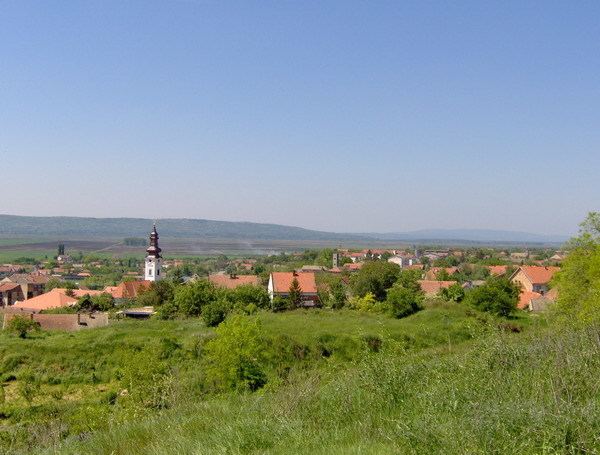Settlements 6 Area code +381 21 Area 262 km² Postal code 21240 | Time zone CET (UTC+1) Car plates NS Local time Saturday 10:21 PM Mayor Milivoj Petrović | |
 | ||
Weather 14°C, Wind SE at 21 km/h, 38% Humidity | ||
Titel (Serbian Cyrillic: Тител) is a town and municipality located in the South Bačka District of the autonomous province of Vojvodina, Serbia. The town of Titel has a population of 5,247, while the population of the municipality of Titel is 15,738. It is located in southeastern part of the geographical region of Bačka, known as Šajkaška.
Contents
- Map of Titel Serbia
- Name
- History
- Inhabited places
- Ethnic groups 2011 census
- Historical population of the town
- Politics
- Notable people
- References
Map of Titel, Serbia
Name
In Serbian, the town is known as Titel (Тител), in Hungarian as Titel, in German as Titel (and sometimes Theisshügel), and in Latin as Titulium.
History
The Titel Plateau is an elevated region between the Danube and Tisza rivers, close to the confluence; about 16 by 7 kilometres (9.9 by 4.3 miles); roughly 80 square kilometres (31 square miles). It has an ellipsoid form and is characterized by steep slopes at the margins. It has a substantial loess cover and is often called the Titel Loess Plateau; the loess on the plateau is considered to contain the most detailed terrestrial palaeoclimate records in Europe, with a thick and apparently continuous record extending to the middle and late Early Pleistocene. It represents a major archaeological site at the Danube-Tisza confluence with prehistoric and ancient findings.
Early medieval sources are scarce. Slavs are mentioned in the area in the late 7th and early 8th century, while Magyars (Hungarians) settled the Pannonian Plain in 896, already in the next century holding the Tisa-Danube confluence. Grand Prince Árpád (r. 895–907) is believed to have defeated the Bulgars (Salan) at Titel. Titel was an important strategical location, and was included in the Bács County. Ladislaus I of Hungary (r. 1077–95) and his brother Lampert founded an Augustinian monastery here. On 17 October 1389 a Clement was inscribed at the Vienna University, who in Titel taught reading and cantillation. In 1439 Albert II's army awaited in Titel military aid from the county to help Đurađ Branković defend Smederevo, but the aid never arrived.
From 1526, the town was part of the Ottoman Empire. According to the first Ottoman census from 1546, the town had 87 houses, of which most were Serb, three were Croat, one Hungarian, and one Vlach. The duke of the town was Vuk Radić. That census recorded that five of the citizens were immigrants, meaning that others lived there before Ottomans conquered the town.
In the outset of the Ottoman rule, the town had one Orthodox and one Catholic church. In the first quarter of the 17th century, the town had three mosques, two tekkes and three medreses.
From 1699, the town was part of the Habsburg Monarchy. It was included in the Habsburg Military Frontier. Between 1750 and 1763, the town was under civil administration (in the Batsch-Bodrog County of the Habsburg Kingdom of Hungary), until it was returned to the jurisdiction of the Military Frontier (Šajkaš Battalion).
In 1848 and 1849, Titel was part of Serbian Vojvodina, a Serb autonomous region within the Habsburg Empire. Between 1849 and 1872, it was again part of the Military Frontier, and after 1872, it came under civil administration as a part of the Bács-Bodrog County within the Habsburg Kingdom of Hungary (part of Austria-Hungary).
After 1918, the town became part of the Kingdom of Serbs, Croats and Slovenes and subsequent South Slavic states. During the World War II Hungarian occupation, in a 1942 raid, 51 inhabitants of the town were murdered, of whom 45 were men, 1 child, and 5 old people. By nationality, victims included 49 Serbs, and 1 Jew.
Inhabited places
Titel municipality encompasses the town of Titel, and the following villages:
Ethnic groups (2011 census)
The total population of the Titel municipality was 15,738, including:
All settlements in the municipality have an ethnic Serb majority.
Historical population of the town
Politics
Seats in the municipal parliament won in the 2004 local elections: [1]
